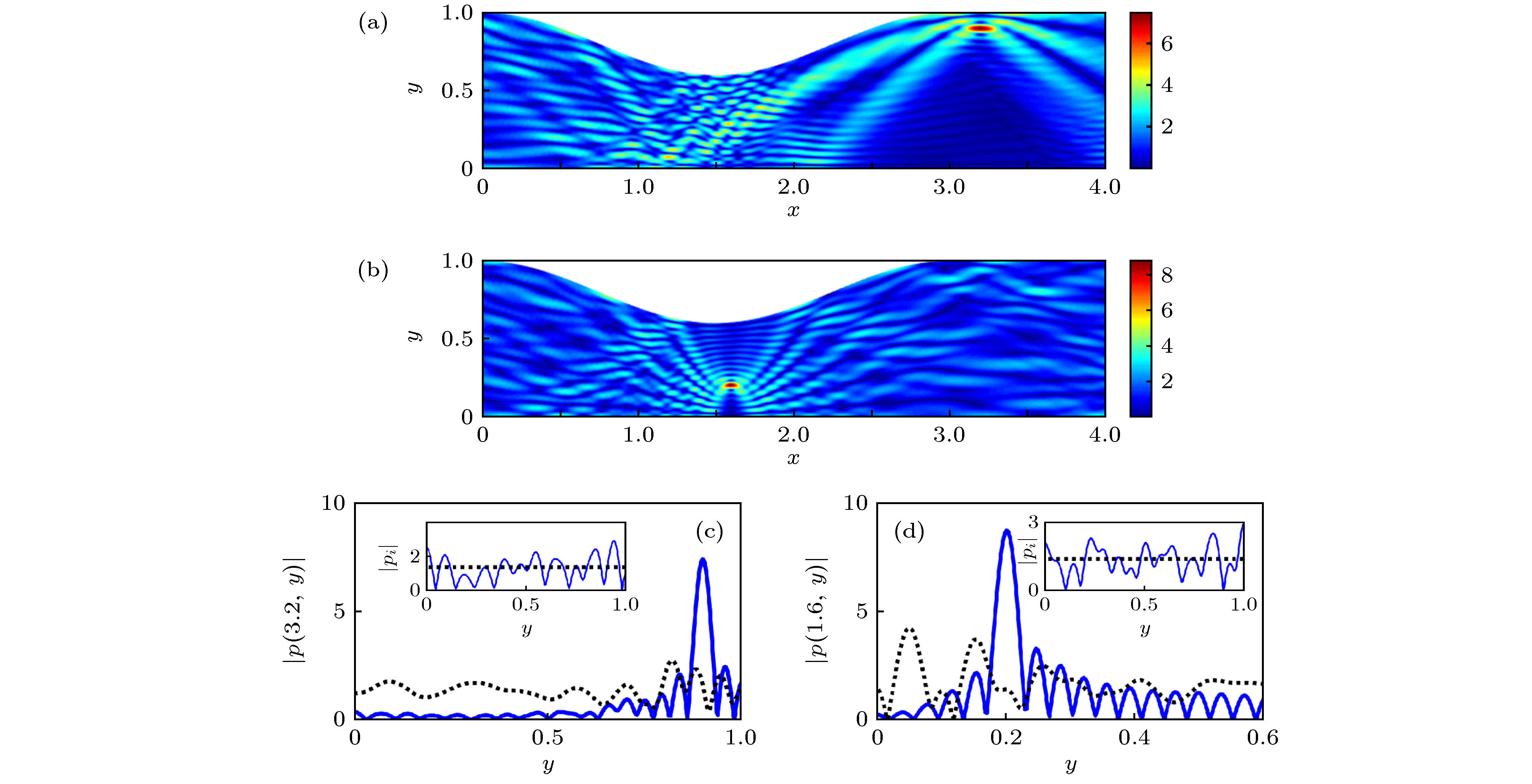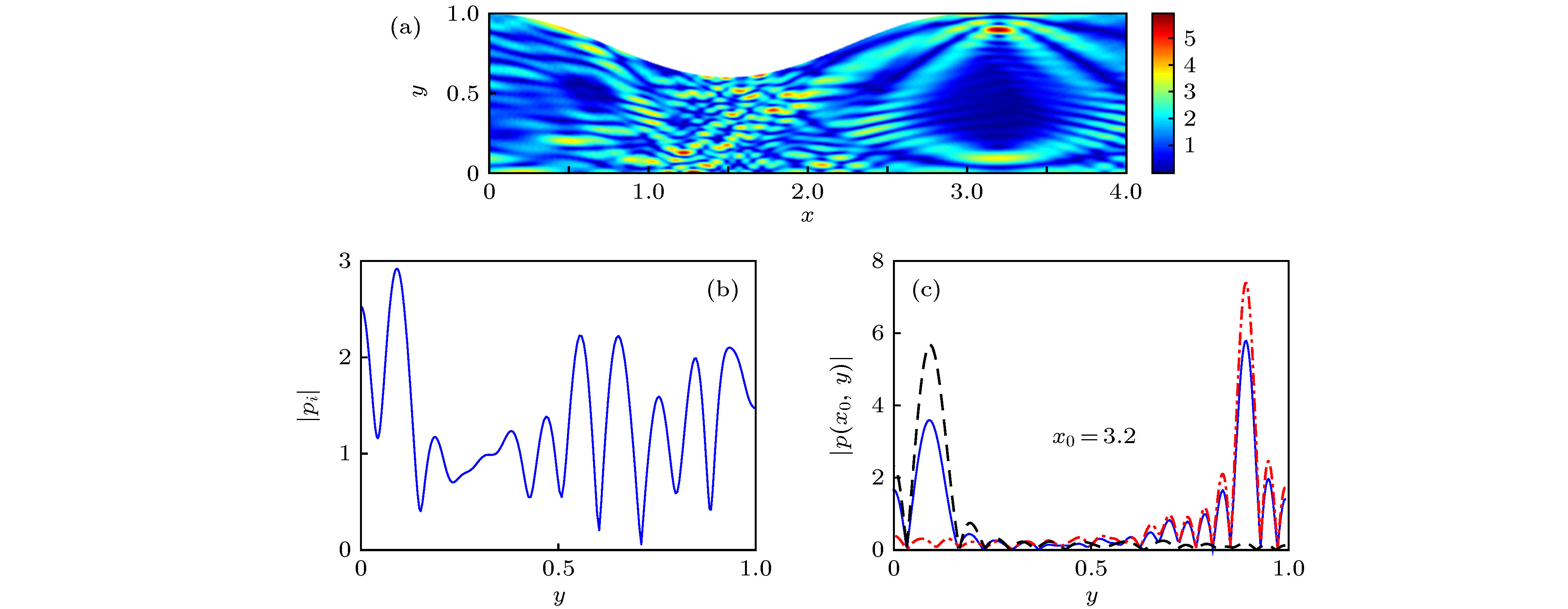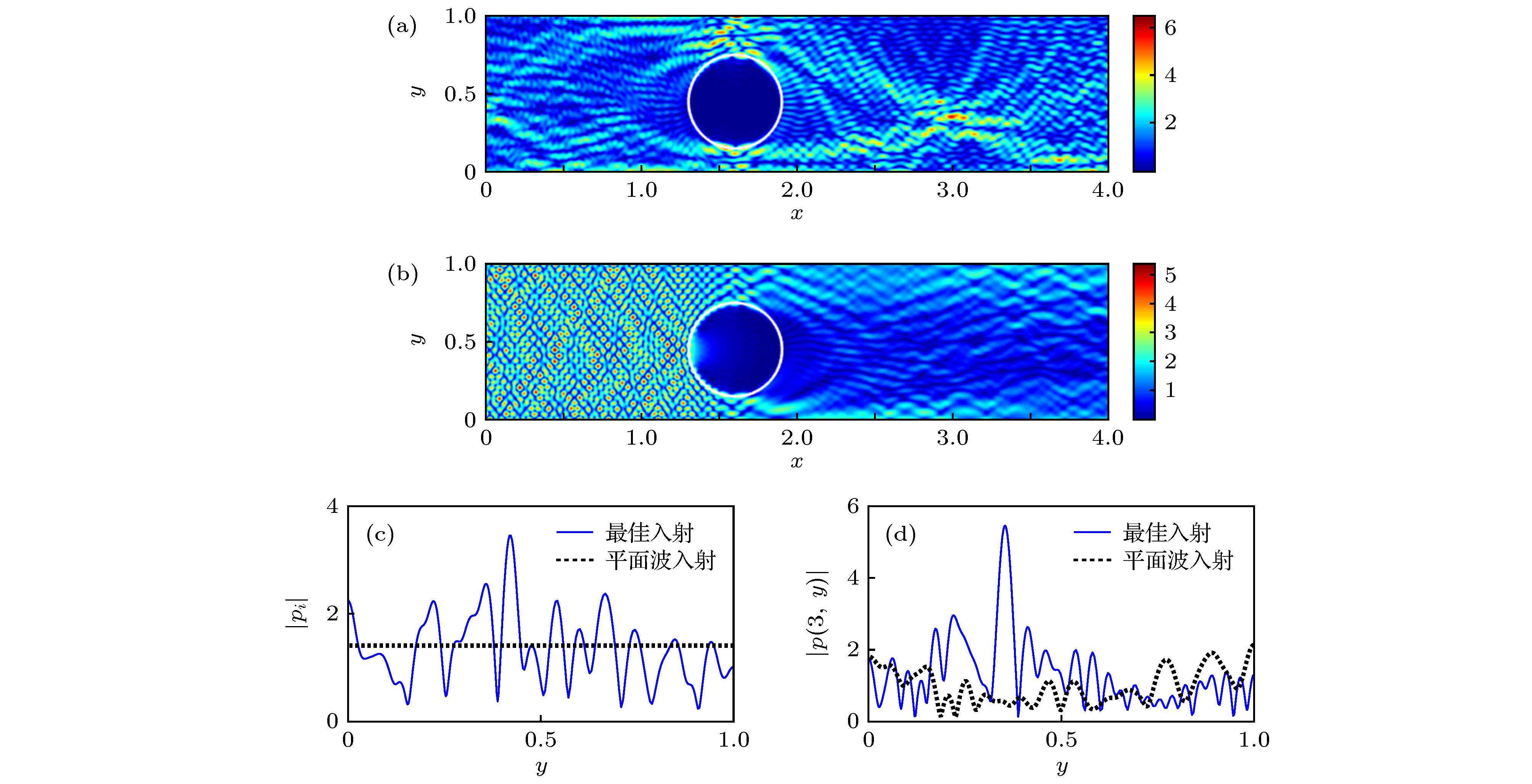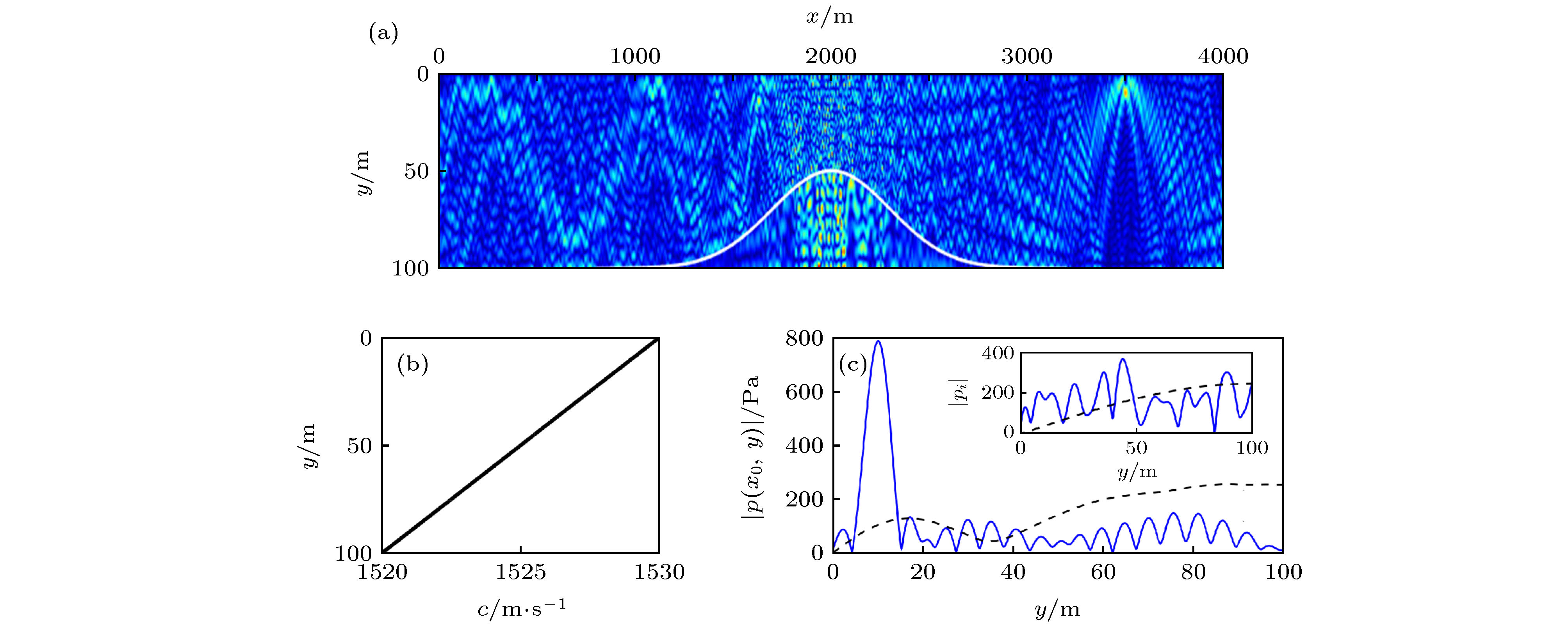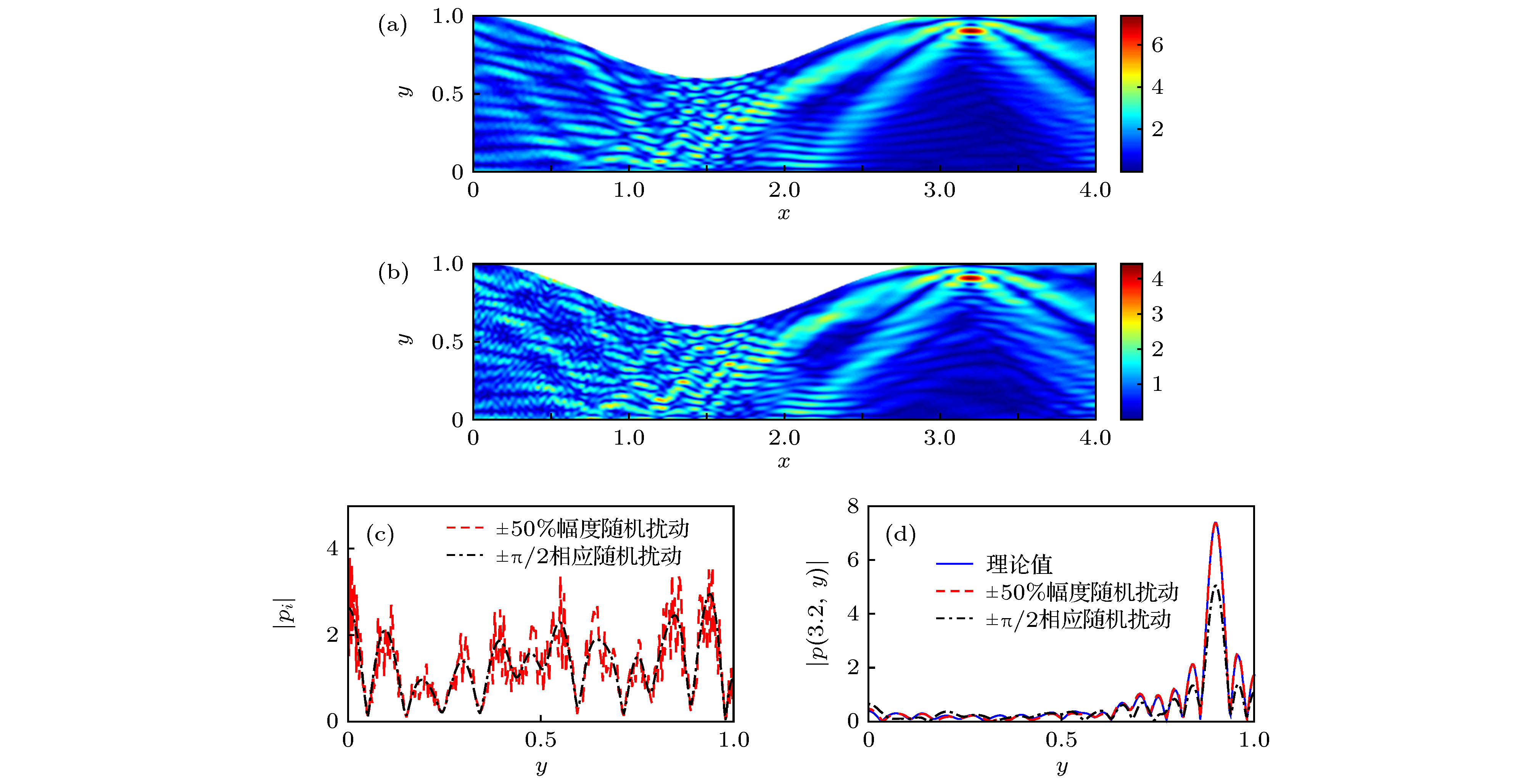-
A method for analytically studying sound focusing in inhomogeneous waveguides is presented. From the viewpoint of acquiring the maximum acoustic pressure at an arbitrary position with normalized energy flux injection, optimal incident waves can be derived based on the multimodal admittance method. The method involves two steps. The first step is to expand the wave solution onto a complete orthogonal basis set so that the Helmholtz equation can be transformed into two sets of first-order coupled differential equations in the modal domain. The second step is to solve the coupled equations numerically by introducing admittance matrices and propagators, which can be used to derive reflection matrices and transmission matrices. Using the multimodal admittance method, one can circumvent the contamination caused by exponentially diverging evanescent modes and acquire stable wave solutions. Then the mapping between the acoustic pressure at an arbitrary position and that of the incident wave can be constructed, and this mapping changes the problem of wave focusing into solving the extrema of inner products in Hilbert space. The optimal incident waves that generate wave focusing at an arbitrary position can be readily computed together with the corresponding wave solutions. In this paper, we study the sound focusing in waveguides with varying cross-sections, scatterers and sound-speed profiles. The results show that the optimal incident waves will take full advantage of wave scattering caused by the boundaries and inhomogeneities during propagation to achieve the maximum pressure at foci, leading to good single-point and multi-point sound focusing performance. In addition, we find when injecting the spatially sampled optimal incident waves or the optimal incident waves with random perturbations, the resultant wave focusing phenomena will be still apparent. The focusing behaviors are highly robust to the perturbations of the moduli of the incident waves and slightly less robust to that of the arguments of the incident waves. Our method is also available for analyzing wave focusing in other kinds of inhomogeneous waveguides. We believe that our research can provide guidance on designing acoustic lenses or metamaterials to focus sound waves in complex media, and can offer inspiration in wave communications, imagings and non-destructive testing.
[1] Gupta B C, Ye Z 2003 Phys. Rev. E 67 036603
 Google Scholar
Google Scholar
[2] Håkansson A, Cervera F, Sánchez-Dehesa J 2005 Appl. Phys. Lett. 86 054102
 Google Scholar
Google Scholar
[3] Climente A, Torrent D, Sánchez-Dehesa J 2010 Appl. Phys. Lett. 97 104103
 Google Scholar
Google Scholar
[4] Guenneau S, Movchan A, Pétursson G, Ramakrishna S A 2007 New J. Phys. 9 399
 Google Scholar
Google Scholar
[5] 刘宸, 孙宏祥, 袁寿其, 夏建平 2016 物理学报 65 174
Liu C, Sun H X, Yuan S Q, Xia J P 2016 Acta Phys. Sin. 65 174
[6] 刘宸, 孙宏祥, 袁寿其, 夏建平, 钱姣 2017 物理学报 66 167
Liu C, Sun H X, Yuan S Q, Xia J P, Qian J 2017 Acta Phys. Sin. 66 167
[7] Zel'dovich B Y, Popovichev V I, Ragul'skii V V, Faizullov F S 1972 JETP Lett. 15 109
[8] Papadopoulos I N, Farahi S, Moser C, Psaltis D 2012 Opt. Express 20 10583
 Google Scholar
Google Scholar
[9] Popoff S M, Lerosey G, Carminati R, Fink M, Boccara A C, Gigan S 2010 Phys. Rev. Lett. 104 100601
 Google Scholar
Google Scholar
[10] Rotter S, Gigan S 2017 Rev. Mod. Phys. 89 015005
 Google Scholar
Google Scholar
[11] Vellekoop I M, Mosk A P 2007 Opt. Lett. 32 2309
 Google Scholar
Google Scholar
[12] van Putten E G, Akbulut D, Bertolotti J, Vos W L, Lagendijk A, Mosk A P 2011 Phys. Rev. Lett. 106 193905
 Google Scholar
Google Scholar
[13] Aulbach J, Gjonaj B, Johnson P M, Mosk A P, Lagendijk Ad 2011 Phys. Rev. Lett. 106 103901
 Google Scholar
Google Scholar
[14] Katz O, Small E, Bromberg Y, Silberberg Y 2011 Nat. Photonics 5 372
 Google Scholar
Google Scholar
[15] McCabe D J, Tajalli A, Austin D R, Bondareff P, Walmsley I A, Gigan S, Chatel B 2011 Nat. Commun. 2 447
 Google Scholar
Google Scholar
[16] Mounaix M, Andreoli D, Defienne H, Volpe G, Katz O, Grésillon S, Gigan S 2016 Phys. Rev. Lett. 116 253901
 Google Scholar
Google Scholar
[17] Fink M, Cassereau D, Derode A, Prada C, Roux P, Tanter M, Thomas J L, Wu F 2000 Rep. Prog. Phys. 63 1933
 Google Scholar
Google Scholar
[18] Derode A, Roux P, Fink M 1995 Phys. Rev. Lett. 75 4206
 Google Scholar
Google Scholar
[19] 殷敬伟, 惠娟, 惠俊英, 生雪莉, 姚直象 2007 声学学报 32 362
 Google Scholar
Google Scholar
Yin J W, Hui J, Hui J Y, Sheng X L, Yao Z X 2007 Acta Acust. 32 362
 Google Scholar
Google Scholar
[20] Maurel A, Mercier J F, Félix S 2014 J. Acoust. Soc. Am. 135 165
 Google Scholar
Google Scholar
[21] Bandres M A, Gutiérrez-Vega J C, Chávez-Cerda S 2004 Opt. Lett. 29 44
 Google Scholar
Google Scholar
[22] Pagneux V, Amir N, Kergomard J 1996 J. Acoust. Soc. Am. 100 2034
 Google Scholar
Google Scholar
[23] Lu Y Y, McLaughlin J R 1996 J. Acoust. Soc. Am. 100 1432
 Google Scholar
Google Scholar
[24] Pagneux V 2010 J. Comput. Appl. Math. 234 1834
 Google Scholar
Google Scholar
[25] Lu Y Y 2005 J. Comput. Appl. Math. 173 247
 Google Scholar
Google Scholar
[26] Maurel A, Mercier J F, Pagneux V 2014 Proc. R. Soc. A 470 20130448
 Google Scholar
Google Scholar
[27] Li Q, Liu J, Guo W 2020 Chin. Phys. B 29 014303
 Google Scholar
Google Scholar
[28] 黄益旺 2005 博士学位论文(哈尔滨: 哈尔滨工程大学)
Huang Y W 2005 Ph. D. Dissertation (Harbin: Harbin Engineering University) (in Chinese)
[29] Popoff S M, Lerosey G, Fink M, Boccara A C, Gigan S 2011 New J. Phys. 13 123021
 Google Scholar
Google Scholar
[30] Kim M, Choi W, Choi Y, Yoon C, Choi W 2015 Opt. Express 23 12648
 Google Scholar
Google Scholar
-
图 3 (a)和(b)为变截面波导分别在
$\left( {{x_0}, {y_0}} \right) = (3.2, 0.9)$ (透射区域)及$(1.6, 0.2)$ (散射区域)处产生聚焦的声场; (c)和(d)主图中的蓝色实线分别为(a)和(b)中${x_0}$ 处的声压幅值随高度方向的分布, 黑色点线为${p_i} = \varLambda {\psi _0}\left( y \right)$ (平面波)时${x_0}$ 处的声压幅值分布; 插图中的蓝色曲线和黑色点线分别为最佳入射波及平面波的幅值曲线Fig. 3. Acoustic focusing field in the waveguide as calculated by the present method. The foci are located at (a)
$\left( {{x_0}, {y_0}} \right) = $ (3.2, 0.9) in transmission region and (b)$(1.6, 0.2)$ in scattering region, respectively. The blue solid lines in (c) and (d) are$\left| {p({x_0}, y)} \right|$ corresponding to (a) and (b), respectively, and the black dotted lines are$\left| {p({x_0}, y)} \right|$ generated by${p_i} = \varLambda {\psi _0}\left( y \right)$ (plane wave). The insets plot the modulus of the corresponding incident waves.图 4 (a) 变截面波导中的双点聚焦声场, 聚焦点为
$(3.2, 0.9)$ 及$(3.2, 0.1)$ ; (b) 最佳入射声压幅值分布; (c) 蓝色实线为(a)中声场在$x = 3.2$ 处的声压幅值分布; 红色点划线表示声波在$(3.2, 0.9)$ 处单点聚焦时的声压幅值分布, 与图3(c)中蓝色曲线一致; 黑色虚线为声波在$(3.2, 0.1)$ 处单点聚焦时的声压幅值分布. 频率和波导几何参数与图3一致Fig. 4. (a) Sound two-point focusing field in the waveguide with varying cross-section, the foci are located at
$(3.2, 0.9)$ and$(3.2, 0.1)$ ; (b) modulus of the optimal incident pressure; (c) the blue solid line represents$\left| {p(3.2, y)} \right|$ in (a); the red dot-dashed line shows$\left| {p(3.2, y)} \right|$ when the wave focus only at$(3.2, 0.9)$ , which is same as the blue solid line in Fig. 3(c); and the black dashed line shows$\left| {p(3.2, y)} \right|$ when the wave focus only at$(3.2, 0.1)$ . The frequency and geometries of the waveguide are same as Fig. 3.图 6 (a) 含散射体波导中的聚焦声场, 聚焦点位于
$(3, 0.35)$ ; (b)${p_i} = \varLambda {\psi _0}\left( y \right)$ (平面波)入射时的声场; (c) 产生(a)中声聚焦的最佳入射波(蓝色实线)与入射平面波(黑色点线)的幅值分布; (d) 蓝色实线与黑色点线分别为(a)与(b)中$x = 3$ 处的声压幅值分布Fig. 6. (a) Sound focusing field in the waveguide with a scatterer. The focus is located at
$(3, 0.35)$ ; (b) sound field generated by a plane wave${p_i} = \varLambda {\psi _0}\left( y \right)$ ; (c) modulus of the pressure of optimal incident wave in (a) and that of the plane incident wave in (b); (d)$\left| {p(3, y)} \right|$ in (a) (blue solid line) and (b) (black dotted line).图 7 (a) 负声速梯度含散射体浅海波导中的声聚焦, 波导深度
$h = 100\;{\rm{ m}}$ , 聚焦点$(35 h, 0.1 h)$ 位于透射区域; (b)声速垂直变化情况; (c)$x = 35 h$ 处声压幅值随深度的变化曲线(蓝色实线)以及${p_i} = \varLambda {\psi _0}\left( y \right)$ (非平面波)入射时产生的声压(黑色虚线)对比, 插图中为最佳入射波及${p_i} = \varLambda {\psi _0}\left( y \right)$ 的幅值分布Fig. 7. (a) Sound focusing field in the waveguide with negative sound-speed gradient and a scatterer. The focus is located at
$(35 h, 0.1 h)$ , where$h = 100\;{\rm{ m}}$ is the depth; (b)the sound speed profile; (c)$\left| {p(35 h, y)} \right|$ (blue solid line) compared with that generated by${p_i} = \varLambda {\psi _0}\left( y \right)$ . The insetplotsthe modulus of the optimal incident pressure (blue solid line) and$\varLambda {\psi _0}\left( y \right)$ (black dashed line).图 8 y方向稀疏输入对聚焦结果的影响 (a) 对最佳入射波进行半波长采样后的聚焦声场;(b) 对最佳入射波进行单倍波长采样后的聚焦声场;(c)采样后的入射波幅值分布; (d) 聚焦点
${x_0}$ 处的声压幅值分布. 蓝色实线为理论值, 与图3(c)中的蓝色曲线一致Fig. 8. Sound focusing fields when the optimal incident wave is discretized: (a) Half-wavelength spacing; (b) single-wavelength spacing; (c) the moduli of the two spaced incident waves; (d) the red dashed line and the black dot-dashed line are the corresponding
$\left| {p(3.2, y)} \right|$ generated by the incident waves in (c). The blue solid line is the theoretical result which is same as that in Fig. 3(c).图 9 (a) 最佳入射波的幅值存在随机扰动时的聚焦声场; (b) 最佳入射波的相位存在随机扰动时的聚焦声场; (c) 红色虚线与黑色点划线分别为幅值扰动与相位扰动后的入射波幅值分布; (d) 红色虚线与黑色点划线分别为(c)中的入射波在聚焦点
${x_0}$ 处产生的声压幅值分布, 蓝色实线为理论值, 与图3(c)中的蓝色曲线一致Fig. 9. Sound focusing fields when (a) the moduli and (b) the arguments of the optimal incident wave are perturbed; (c) the red dashed line is the incident wave with perturbed moduli, and the black dot-dashed line is that with perturbed arguments; (d) the red dashed line and the black dot-dashed line are the corresponding
$\left| {p(3.2, y)} \right|$ generated by the incident waves in (c). The blue solid line is the result without perturbation which is same as that in Fig. 3(c). -
[1] Gupta B C, Ye Z 2003 Phys. Rev. E 67 036603
 Google Scholar
Google Scholar
[2] Håkansson A, Cervera F, Sánchez-Dehesa J 2005 Appl. Phys. Lett. 86 054102
 Google Scholar
Google Scholar
[3] Climente A, Torrent D, Sánchez-Dehesa J 2010 Appl. Phys. Lett. 97 104103
 Google Scholar
Google Scholar
[4] Guenneau S, Movchan A, Pétursson G, Ramakrishna S A 2007 New J. Phys. 9 399
 Google Scholar
Google Scholar
[5] 刘宸, 孙宏祥, 袁寿其, 夏建平 2016 物理学报 65 174
Liu C, Sun H X, Yuan S Q, Xia J P 2016 Acta Phys. Sin. 65 174
[6] 刘宸, 孙宏祥, 袁寿其, 夏建平, 钱姣 2017 物理学报 66 167
Liu C, Sun H X, Yuan S Q, Xia J P, Qian J 2017 Acta Phys. Sin. 66 167
[7] Zel'dovich B Y, Popovichev V I, Ragul'skii V V, Faizullov F S 1972 JETP Lett. 15 109
[8] Papadopoulos I N, Farahi S, Moser C, Psaltis D 2012 Opt. Express 20 10583
 Google Scholar
Google Scholar
[9] Popoff S M, Lerosey G, Carminati R, Fink M, Boccara A C, Gigan S 2010 Phys. Rev. Lett. 104 100601
 Google Scholar
Google Scholar
[10] Rotter S, Gigan S 2017 Rev. Mod. Phys. 89 015005
 Google Scholar
Google Scholar
[11] Vellekoop I M, Mosk A P 2007 Opt. Lett. 32 2309
 Google Scholar
Google Scholar
[12] van Putten E G, Akbulut D, Bertolotti J, Vos W L, Lagendijk A, Mosk A P 2011 Phys. Rev. Lett. 106 193905
 Google Scholar
Google Scholar
[13] Aulbach J, Gjonaj B, Johnson P M, Mosk A P, Lagendijk Ad 2011 Phys. Rev. Lett. 106 103901
 Google Scholar
Google Scholar
[14] Katz O, Small E, Bromberg Y, Silberberg Y 2011 Nat. Photonics 5 372
 Google Scholar
Google Scholar
[15] McCabe D J, Tajalli A, Austin D R, Bondareff P, Walmsley I A, Gigan S, Chatel B 2011 Nat. Commun. 2 447
 Google Scholar
Google Scholar
[16] Mounaix M, Andreoli D, Defienne H, Volpe G, Katz O, Grésillon S, Gigan S 2016 Phys. Rev. Lett. 116 253901
 Google Scholar
Google Scholar
[17] Fink M, Cassereau D, Derode A, Prada C, Roux P, Tanter M, Thomas J L, Wu F 2000 Rep. Prog. Phys. 63 1933
 Google Scholar
Google Scholar
[18] Derode A, Roux P, Fink M 1995 Phys. Rev. Lett. 75 4206
 Google Scholar
Google Scholar
[19] 殷敬伟, 惠娟, 惠俊英, 生雪莉, 姚直象 2007 声学学报 32 362
 Google Scholar
Google Scholar
Yin J W, Hui J, Hui J Y, Sheng X L, Yao Z X 2007 Acta Acust. 32 362
 Google Scholar
Google Scholar
[20] Maurel A, Mercier J F, Félix S 2014 J. Acoust. Soc. Am. 135 165
 Google Scholar
Google Scholar
[21] Bandres M A, Gutiérrez-Vega J C, Chávez-Cerda S 2004 Opt. Lett. 29 44
 Google Scholar
Google Scholar
[22] Pagneux V, Amir N, Kergomard J 1996 J. Acoust. Soc. Am. 100 2034
 Google Scholar
Google Scholar
[23] Lu Y Y, McLaughlin J R 1996 J. Acoust. Soc. Am. 100 1432
 Google Scholar
Google Scholar
[24] Pagneux V 2010 J. Comput. Appl. Math. 234 1834
 Google Scholar
Google Scholar
[25] Lu Y Y 2005 J. Comput. Appl. Math. 173 247
 Google Scholar
Google Scholar
[26] Maurel A, Mercier J F, Pagneux V 2014 Proc. R. Soc. A 470 20130448
 Google Scholar
Google Scholar
[27] Li Q, Liu J, Guo W 2020 Chin. Phys. B 29 014303
 Google Scholar
Google Scholar
[28] 黄益旺 2005 博士学位论文(哈尔滨: 哈尔滨工程大学)
Huang Y W 2005 Ph. D. Dissertation (Harbin: Harbin Engineering University) (in Chinese)
[29] Popoff S M, Lerosey G, Fink M, Boccara A C, Gigan S 2011 New J. Phys. 13 123021
 Google Scholar
Google Scholar
[30] Kim M, Choi W, Choi Y, Yoon C, Choi W 2015 Opt. Express 23 12648
 Google Scholar
Google Scholar
计量
- 文章访问数: 11423
- PDF下载量: 151
- 被引次数: 0














 下载:
下载:

